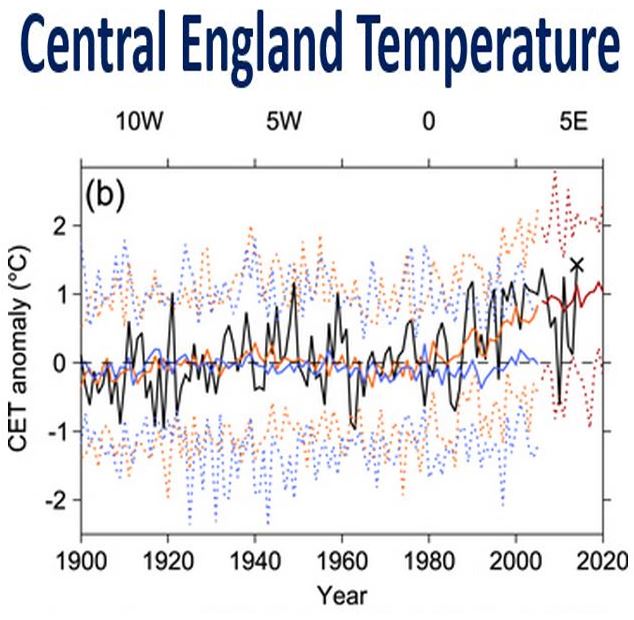England is set to have many more record-breaking super-hot summers caused by human-induced climate change, a team of scientists from Australia, the Netherlands, and the USA reported in the journal Environmental Research Letters.
Last year was England’s warmest ever. The climate specialists, led by Dr. Andrew King from the the ARC Centre of Excellence for Climate System Science at the University of Melbourne, Australia, found that England today is at least 13 times more likely to have record-breaking warm years as a result of human-induced (anthropogenic) climate change.
The research team’s findings came after they analyzed a series of climate model simulations from data obtained from the Central England Temperature (CET) record – the world’s oldest instrumental temperature record, which dates back to 1659.

Timeseries: Observed CET (black). The mean of the historical simulations (solid orange), RCP8.5 simulations (solid red) and historicalNat simulations (solid blue). Max & min values of the modelled CET shown for the historical simulations (dashed orange), RCP8.5 simulations (dashed red) and HistoricalNat simulations (dashed blue). The record annual CET is marked by the black cross. (Image: iopscience.iop.org)
Human activities have a significant influence on extreme warm years in England, which Dr. King and colleagues described as ‘remarkable’, given that it is such a relatively small country.
“When you look at average annual temperatures over larger regions of the world, such as the whole of Europe, there is a lower variability in temperatures from year to year compared with smaller areas.”
“As a result of this low variability, it is easier to spot anomalies. This is why larger regions tend to produce stronger attribution statements, so it is remarkable that we get such a clear anthropogenic influence on temperatures in a relatively small area across central England.”
The scientists arrived at their results by comparing model simulations which looked at the probability of super-hot years when there are only natural forcings on climate with no influence from human activity, against what might happen when natural forcings and human influence are combined.
They then calculated the change in the probability of warm years due to the influence of human activity.
Dr. King and team then studied the CET data and selected the warmest years from the records since 1900, and plotted the hottest years onto a graph. With these data, they calculated the likelihood of warm years occurring now versus that likelihood 100 years ago.
Record-breaking hot years 13 times more likely now
Their mode-based method indicated that the likelihood of a super-warm year now is 13 times more likely (with a 90% confidence) due to human influences on the climate “while the observation-based approach suggested at least a 22-fold increase in the probability of very warm years in the climate of today compared with the climate of a century ago (again with 90% confidence).”

England is set for a growing number of record-hot summers.
Dr. King added:
“Both of our approaches showed that there is a significant and substantial increase in the likelihood of very warm years occurring in central England.”
CET data showed that 2014 was central England’s warmest year ever.
It has been reported that over the past sixty years there has been rapid warming in central England in line with the human-activity influence on the climate. The average temperature for the whole of 2014 was 10.93°C.
The Central England Temperature (CET) series is the oldest instrumental time series of temperatures in the world. Average monthly and daily recordings date back to 1659 and 1772 respectively.
The CET represents the climate of a triangular area in the English Midlands enclosed by London in the south-east, Bristol in the south-west and Lancashire in the north.
The CET is an ideal resource for studying long-term climate trends across the region – it has undergone comprehensive and extensive quality control.
What about other parts of the UK?
Will these record-breaking hot years be felt outside central England?
Dr. King said:
“I would expect that other areas near the UK would produce similar results.”
“For larger regions, stronger attribution statements can often be made. For example, we performed a similar attribution study for Europe as a whole and found a 35-fold increase in the likelihood of extremely warm years using model simulations.”
The study was supported by the Australian Government and the National Computational Infrastructure.
Citation: “Attribution of the record high Central England temperature of 2014 to anthropogenic influences,” Andrew D King and David J Karoly (ARC Centre of Excellence for Climate System Science, School of Earth Sciences, University of Melbourne, Australia), Geert Jan van Oldenborgh (Royal Netherlands Meteorological Institute), Sophie C Lewis (ARC Centre of Excellence for Climate System Science and Research School of Earth Sciences, The Australian National University, Canberra, Australia) and Heidi Cullen (Climate Central, Princeton, USA). Environmental Research Lettter. Published 1 May, 2015. DOI: 10.1088/1748-9326/10/5/054002.
Video – Record warm temperatures Central England

